Abstract
Contamination of wastewater with organic-limited nitrates has become an urgent problem in wastewater treatment. The cooperating heterotrophic with sulfur autotrophic denitrification is an alternative process and the efficiency has been assessed in many studies treating simulated wastewater under different operating conditions. However, due to the complex and diverse nature of actual wastewater, more studies treating actual wastewater are still needed to evaluate the feasibility of collaborative denitrification. In this study, lab-scale experiments were performed with actual nitrate polluted water of two different concentrations, with glucose and sodium thiosulfate introduced as mixed electron donors in the coupling sulfur-based autotrophic and heterotrophic denitrification. Results showed that the optimum denitrification performance was exhibited when the influent substrate mass ratio of C/N/S was 1.3/1/1.9, with a maximum denitrification rate of 3.52 kg -N/(m3 day) and nitrate removal efficiency of 93% in the coupled systems. Illumina high-throughput sequencing analysis revealed that autotrophic, facultative, and heterotrophic bacteria jointly contributed to high nitrogen removal efficiency. The autotrophic denitrification maintained as the predominant process, while the second most prevalent denitrification process gradually changed from heterotrophic to facultative with the increase of influent concentration at optimum C/N/S ratio conditions. Furthermore, the initiation of dissimilatory nitrate reduction to ammonium (DNRA) was very pivotal in promoting the entire denitrification process. These results suggested that sulfur-based autotrophic coupled with heterotrophic denitrifying process is an alternative and promising method to treat nitrate containing wastewater.
1. Introduction
Nitrogen, the most essential substance in the synthesis of key cellular components, such as proteins and nucleic acids, is an indispensable constituent in all living organisms [1]. Human activity substantially increases the use and migration of nitrogen in most of the Earth, resulting in nitrogen pollution, which poses a significant threat to the ecological environment and human health [2]. In the context of global green and low-carbon development and transformation, treating wastewater containing nitrate and insufficient carbon content has been proved as the inevitable goal for upgrading the water treatment industry [3].
Biological denitrification technology, as the most economical and effective method for nitrate removal, has been widely and exclusively studied from the perspective of autotrophic and heterotrophic denitrification. In recent years, considerable attentions have been paid to the utilization of various external carbon sources and produced intermediates to enhance nitrate removal during heterotrophic denitrification [4]. In practice, the denitrification rate is higher during heterotrophic conditions, however, the associated problems, such as secondary pollution, high sludge production rates, and increased operating costs are difficult to control [5,6]. Sulfur-based autotrophic denitrification has been considered as an alternative process owing to its stability, non-toxicity, cost-effectiveness, and eco-friendly operation under normal conditions [7,8]. However, the main disadvantages of sulfur-based autotrophic denitrification, including sulfate and acid generation, have limited the large-scale promotion of this process [9,10]. Thus, several researchers have attempted the participation of various electron donors by cooperating heterotrophic with sulfur autotrophic denitrification in specific reactors [11,12], and found that collaborative denitrification not only achieved the acid-base balance of the reaction system [13], but also improved the rate of denitrification and reduced the sludge yield [14] (Equations (1) and (2)). Therefore, most studies have been focused on treating simulated wastewater under different operating conditions [15,16]; however, production control during the mixotrophic processes for actual wastewater has rarely been studied [17]. The composition of the actual wastewater is more complex and diverse than simulated wastewater, thus, studies with actual wastewater will be more representative and better to evaluate the feasibility of coupling sulfur-based autotrophic and heterotrophic denitrification.
In this study, experiments of coupling sulfur-mediated autotrophic and heterotrophic denitrification were conducted to treat actual wastewater. Glucose and sodium thiosulfate were selected as the available electron donors because of their natural advantage, which can completely interact with the pollutants in the aquatic environment [18,19]. High-nitrate industrial wastewater and low-nitrate municipal sewage were treated by changing their trophic conditions and operating loads, respectively. The differences in denitrification performance and microbial community were investigated and compared, and the related biological nitrogen removal pathways and mechanisms were elucidated.
2. Materials and Methods
2.1. Experimental Wastewater
The secondary effluents collected from the sewage treatment station for sucralose production and the Suzhou municipal sewage treatment plant (Suzhou, China) were considered as experimental wastewater, and labeled WH and WL, respectively. The components of the two experimental wastewater are shown in Table 1. The main nitrate pollutant was excess in WH and minor in WL, with reference to the maximum allowable concentration of 15 mg/L -N in the discharge standard of pollutants for municipal wastewater treatment plants in China. The inlet water was distributed as required and controlled using peristaltic pumps.

Table 1.
Influent composition of the two experimental wastewater.
2.2. Experimental Apparatus and Operation
Two identical laboratory-scale upflow anaerobic column reactors were established with a working volume of 3 L and operated at 30 ± 2 °C using heated water. The reactors were made of plexiglass and packaged with aluminum foil to prevent light penetration, and a three-phase separation device was installed in each reactor [20]. Activated sludge from two sources, one collected from the anaerobic tank of a sewage treatment station of a dried bean plant and the other from the oxygen tank of a municipal sewage treatment plant, was inoculated in the reactors respectively, corresponding to the varying concentrations of the influent wastewater, with glucose as the organic carbon source. After the stable operation of the heterotrophic denitrification process, Na2S2O3 was added to the influent as a sulfur source to realize the coexistence of heterotrophic and autotrophic bacteria, and the coupling of autotrophic and heterotrophic denitrification systems. The C/N/S ratio mentioned later refers to the mass ratio of COD to -N to elemental sulfur.
The reactors were operated for approximately 200 days under 14 different operating conditions (Table 2) to analyze the effects of various parameters following comparisons: (1) in phase I-1–phase III-2, the influence of C/N/S ratio and influent load on nitrogen removal was assessed for high-nitrate industrial wastewater in reactor A; (2) in phase I’-1–phase II’-4, the applicability of the impact of C/N/S ratio and influent load in (1) was confirmed for low-nitrate municipal wastewater in reactor B.

Table 2.
Operating conditions of reactors used in this study.
2.3. Measurements of Physicochemical Properties
The mixed liquid samples were collected and filtered through a disposable microporous filter membrane (pore size of 0.45 μm). -N, -N, -N, COD, and in the reactor influent and effluent were determined according to the standard methods for the examination of water and wastewater [21]. The temperature and pH were measured using a portable pH meter (7110, WTW, Munich, Germany).
2.4. Analysis of Microbial Community Dynamic
Microbial diversity analysis of the sludge used for inoculation, as well as domesticated at the optimum operating phase in the coupled system, was analyzed with MiSeq high-throughput sequencer (Illumina, Inc., San Diego, CA, USA). The samples were crushed with a tissue grinder and centrifuged for 10 min. Genomic DNA was extracted from sediment using a soil DNA kit (M5635-02, Omega Biotek, Norcross, GA, USA) according to the manufacturer’s instructions. Products above 400 bps were purified and quantified after two rounds of polymerase chain reaction (PCR), and finally sequenced on the Illumina MiseqTM platform (Illumina, Inc., San Diego, CA, USA). Alpha-diversity indexes, including Shannon, Simpson, Ace, and Chao were calculated to reflect the richness and diversity of microbial communities using Mothur 1.30.1 software (Mothur Org., Ann Arbor, MI, USA; https://mothur.org/wiki/calculators/, accessed on 10 October 2021).
3. Result and Discussion
3.1. Wastewater Treatment Performance
3.1.1. Start-Up of the Coupling System under Mainstream Conditions
Nitrogen concentrations in reactor A (including -N, -N, and -N) in the influent and effluent in different phases are shown in Figure 1a, and the TOC, COD, and pH variations throughout the experimental period are presented in Figure 1b,c. In phase I-1 of the operation, the high-nitrate contaminated influent was diluted to promote the formation of autotrophic and heterotrophic bacteria. The theoretical amounts of glucose and sodium thiosulfate were added at a C/N/S ratio of 2.4/1/1.9, which were computed based on the stoichiometry of Equations (1) and (2), in case the two denitrification processes contributed similarly. From the third day onwards, the effluent pH decreased from 7.86 to 7.48 due to acid generation in the autotrophic process (Equation (2)), and the -N concentration in the effluent was less than 68.8 mg/L, resulting in the highest nitrate removal efficiency of 91.9%, which then remained stable, facilitating the maximal growth of autotrophic bacteria during the process.
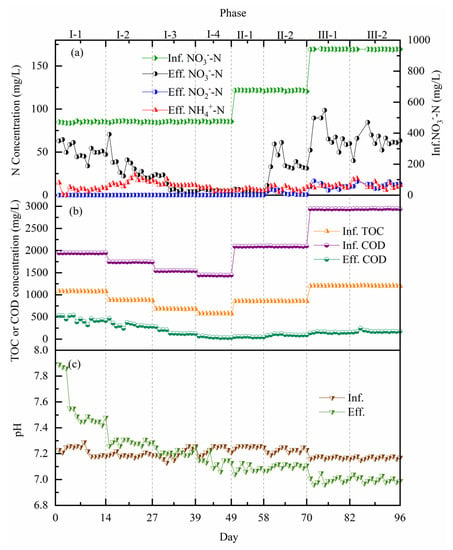
Figure 1.
Changes in (a) nitrogen species, (b) COD or TOC, and (c) pH concentrations in denitrifying reactor A during the entire operation.
The overall denitrification performance in reactor B is presented in Figure 2a–c. When reactor B was initially started up in phase I’-1 of the operation, low-nitrate containing municipal sewage was added directly with glucose and sodium thiosulfate at a C/N/S ratio of 1.3/1/1.9 (according to the optimal ratio resulting from reactor A) to promote autotrophic and heterotrophic bacterial growth. From the third day, the effluent pH decreased from 7.72 to 7.65, and the -N concentration in the effluent was less than 0.75 mg/L, resulting in the highest nitrate removal efficiency of 97.9%, which then remained stable, with maximal growth of autotrophic bacteria during the process. This was consistent with reactor A, and exhibited a shorter start-up time than that using single elemental sulfur as electron donor. The rapid start-up and excellent nitrate removal performance were attributed to substantial contact between the electron donor and the sludge [4], and the effective combination of autotrophic and heterotrophic denitrification [11].
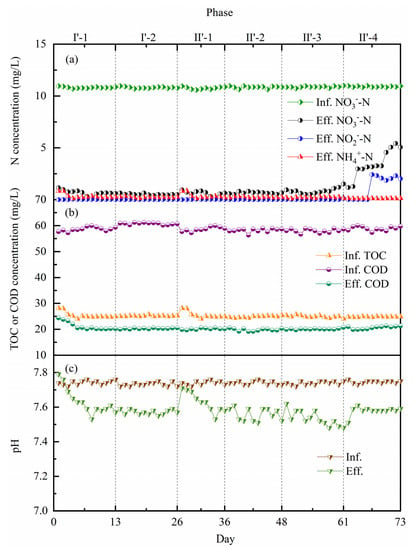
Figure 2.
Changes in (a) nitrogen species, (b) COD or TOC, and (c) pH concentrations in denitrifying reactor B during the entire operation.
3.1.2. Nitrogen Removal Performances under Different Trophic Conditions
From day 15, with the C/N/S ratios of 1.9/1/1.9 (phase I-2), 1.5/1/1.9 (phase I-3), and 1.3/1/1.9 (phase I-4), the -N removal efficiency in reactor A significantly increased with a decrease in carbon sources, which demonstrated that excess carbon sources inhibit the progress of denitrification. Up to phase I-4, the -N removal efficiency was approximately 99% with no -N accumulation; the effluent pH was steadily maintained at 7.1–7.2, which was within the most suitable range for microbial growth (6.8–8.2) [8], and the effluent COD concentration was 30 mg/L (speculated to be non-biodegradable in the original water). Furthermore, the color of the sludge in the reactor gradually turned grey-brown, indicating that the coupled denitrification system was established successfully.
Reactor B was operated in a similar manner as reactor A to check if the coupled denitrification system was the same applied to treating the low-nitrate secondary effluent from the municipal sewage treatment plant. In the phase I’-1 at C/N/S ratio of 1.3/1/1.9, the -N removal efficiency reached 94% with the effluent -N concentration of 0.65 mg/L, and the effluent COD concentration was 24.8 mg/L, which was similar to that of the raw water. Furthermore, when the C/N/S ratio was set at 1.3/1/2.4 by increasing the influent Na2S2O3 concentration in phase I’-2, the nitrate concentration in the effluent was not obviously affected, while the effluent COD increased, which indicates that excess electron donors are unnecessary.
Therefore, a C/N/S ratio of 1.3/1/1.9 was optimal in treating the two experimental wastewaters. Mixed external autotrophic and heterotrophic electron donors can achieve considerably better denitrification efficiency than any single process, and the added carbon source (1.3 mg COD/mg -N) was practically half the theoretical value (2.4 mg COD/mg -N). The fraction of nitrate removed by heterotrophic denitrification might be lower than that of the autotrophic denitrification, and microbes may affect the utilization of COD. Moreover, some organic matter can also be provided from microbial products and degraded biofilms [22].
3.1.3. Nitrogen Removal Efficiencies under Different Pollution Loads
Nitrate pollution load in reactor A was gradually increased by reducing the dilution and HRT from 0.95 kg/(m3·day) to 3.78 kg/(m3·day) in the remaining phases (II-1~III-2); after a brief unsatisfactory fluctuation, the corresponding -N removal efficiency decreased from 99% to 93%. Ultimately, -N removal load reached 3.52 kg/(m3·day), which was relatively higher than the values 2.16 kg/(m3·day), 0.2 kg/(m3·day), and 0.25 kg/(m3·day) observed for other denitrification process in previous study [23,24], with single or mixed electron donor, and pH was not adversely affected (steady around 7) in the coupled denitrification system [25]. In reactor B, the nitrate pollution load was increased by adjusting the HRT to 6 h (0.019 kg/(m3·day), phase II’-1), 4 h (0.029 kg/(m3·day), phase II’-2), 2 h (0.058 kg/(m3·day), phase II’-3), and 1 h (0.116 kg/(m3·day), phase II’-4). The -N removal efficiency was steady at approximately 93%, except in phase II’-4 (49.7%), indicating no significant differences (HRT > 2 h) under low nitrogen pollution load (0.058 kg/(m3·day)).
Therefore, HRT and volumetric loading rate that presented 93% denitrification efficiency were 6 h and 3.52 kg/(m3·day), respectively, for the high-nitrate industrial wastewater (WH); and 2 h and 0.058 kg/(m3·day), respectively, for the low-nitrate municipal sewage (WL), with identical C/N/S ratio of 1.3/1/1.9. The improved nitrate removal and denitrification capacity might be attributed to the enhanced nitrogen and sulfur metabolism of the coupled process.
3.2. Microbial Community Analysis
3.2.1. The Diversity and Richness of the Microbial Community
Illumina high-throughput sequencing was performed to characterize the microbial community. The two types of inoculated sludge were collected and labeled as A1 and B1, while domesticated sludge formed at the optimum operating phase in the reactors was collected as A2 and B2 with a denitrification rate of 3.52 kg -N/(m3·day) and 0.058 kg -N/(m3·day), respectively. The alpha indices including diversity index (Shannon and Simpson) and richness estimator (Ace and Chao) of samples with good coverage over 99% are presented in Table 3. The richness indexes of domesticated sludge decreased when compared with the inoculated sludge in this study, and the variation tendency of diversity indexes was typically similar to richness indexes. An observable reduction in diversity and richness (33% and 22.5%) was observed in reactor A sludge, which might be attributed to a high -N stress (960 mg/L), leading to a massive decline in microbial diversity under extreme nutrient deficiencies. Sample B1 was speculated to contain the richest microbial community; the inoculated sludge from the municipal sewage treatment plant used to treat complex wastewater under different substrate conditions with mixed electron donors could promote microbial diversity [26]. Furthermore, the Operational Taxonomic Unit (OTU) Venn diagram (Figure 3) showed that the number of shared OTUs in samples (A1 to A2 and B1 to B2) were 180 and 1250, which accounted for 37.6% and 69.2% of the previous OTUs, respectively, suggesting a dramatic change in the microbial community during the transformation to coupled conditions [27].

Table 3.
The OTU numbers and bacterial diversity indices of sludge samples.
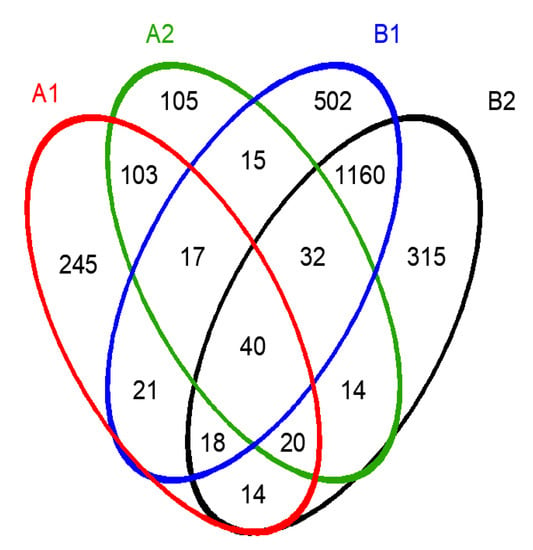
Figure 3.
OTU Venn analysis of sample A1–B2.
3.2.2. Changes in Microbial Community Structure
The microbial community structures of the samples were analyzed at the phylum and class levels, and the significant differences between the inoculated sludge and the domesticated sludge are shown in Figure 4a,b. As shown in Figure 4a, Proteobacteria was the most dominant phylum in each sludge sample. In the inoculated sludge samples A1 and B1, the dominant Proteobacteria accounted for 27.44% and 24.04%, respectively, followed by Chloroflexi (13.7% and 20.4%), Bacteroidetes (21.99% in B2), and Spirochhaetes (14.4% in A2). While in the domesticated sludge samples A2 and B2, the abundance of Proteobacteria increased to 89.65% and 40.68%, respectively, and the proportion of B2 declined by 54.6% (compared with A2) when influent -N concentration decreased from 960 to 10.95 mg/L. Proteobacteria has been proved to be the main phylum of autotrophic denitrifiers [22], therefore, their high abundance was consistent with the previously derived dominant role of sulfur autotrophic denitrification. Proteobacteria could survive under high/low nitrate trophic conditions and their growth may be stimulated with the potential to resist environmental stress.
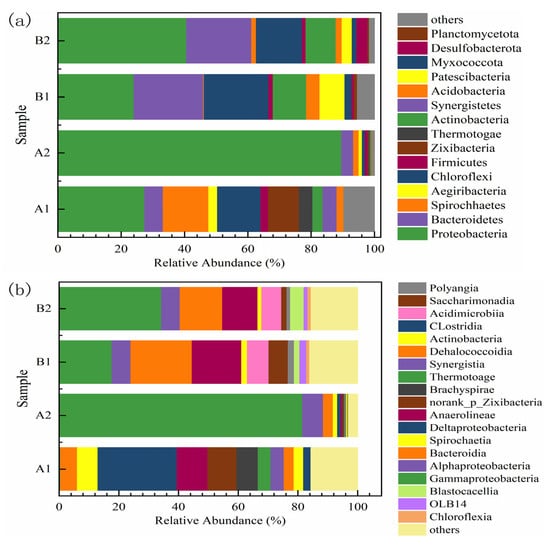
Figure 4.
Community structure analysis of the microbial samples at the (a) phylum and (b) class level.
Gammaproteobacteria, Bacteroidia, Anaerolineae, Alphaproteobacteria, and Actinobacteria were the predominant classes in the sludge samples (Figure 4b). Previous studies have reported a significant correlation of Gammaproteobacteria with denitrification efficiency in mixed denitrification biofilm reactors, which can achieve chemolithoautotrophic metabolism under moderate haloalkaline conditions [9,28]. In the present study, Gammaproteobacteria was the most dominant genus in Proteobacteria, accounting for 81.6% and 34.32% of the domesticated sludge A2 and B2, respectively, and presented an increasing trend with the lift of nitrate removal load.
The microbial composition in response to changes in nutritional conditions was further revealed using the sequence reads obtained from sludge samples that were classified into genus levels, as shown in Figure 5. There were significant differences between the inoculated sludge and domesticated sludge at the genus level (Figure 5a,b). Most microorganisms in inoculated sludge A1 were exhausted, and the functional microorganisms in the domesticated sludge A2 and B2 were the newly emerging denitrifying bacteria. Therefore, the conversion of functional microorganisms in the mixed systems was less affected by the type of sludge inoculated in the study. The autotrophic, facultative, and heterotrophic denitrifying bacteria were found to coexist, accounting for 45.69%, 25.38%, and 8.16% in sludge A2, and accounting for a small proportion of 7.9%, 3.5%, and 7.35% in sludge B2 (Figure 5c), respectively, which suggests that bacterial quantity decreased in low-nitrate wastewater. Therefore, nitrate reduction condition with a C/N/S ratio of 1.3/1/1.9 demonstrated the highest relative abundance of autotrophic denitrifiers, and a higher proportion of facultative denitrifiers appeared at nitrate concentration of 960 mg/L. Presumably, the prevalent denitrification gradually changed from heterotrophic to autotrophic with the increase in influent concentration at low C/N ratios.
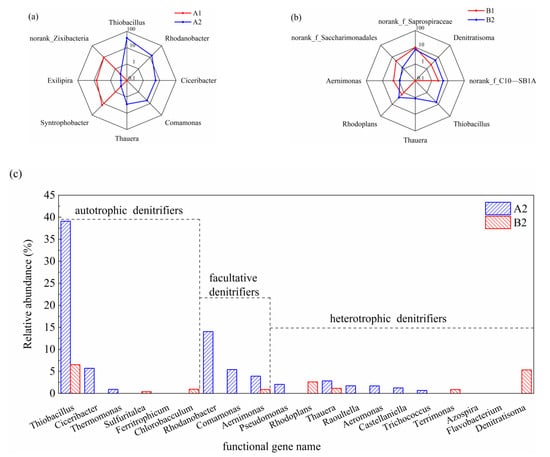
Figure 5.
Transformation of functional genus from sludge (a) A1 to A2, (b) B1 to B2, and (c) differences of functional microbial genus in different denitrification systems.
Thiobacillus, Ciceribacter, Thermomonas, Chlorobacculum, and Sulfuritalea were identified as the ubiquitously present autotrophic organisms in aquatic habitats and activated sludge in the denitrification process [29,30]. Thiobacillus is a typical sulfur-oxidizing bacterium belonging to Gammaproteobacteria, which can reduce nitrate to nitrogen gas using S0, S2−, and S2 under organic-free and neutral pH conditions [31]. As the most dominant autotrophic denitrifying bacterium throughout the operation, Thiobacillus accounted for 39.09% and 6.52% of the total bacterial community in the domesticated sludge A2 and B2, respectively, indicating its importance at an influent nitrate concentration of 10–960 mg/L. This further indicates that sulfur autotrophic denitrification was the main process in the cooperative system that resulted in nitrate removal, which also explains the reduced effluent pH. Interestingly, the proportion of Thiobacillus in sludge A2 was nearly 6-fold higher than that in sludge B2, implying that high nitrate favored Thiobacillus growth.
The genera Thauera, Denitratisoma, Raoultella, Aeromonas and Castellaniella were detected as heterotrophic denitrifying bacteria, with relative abundances of 2.83%, 0%, 1.72%, 1.7%, and 1.24% in sludge A2, and 1.15%, 5.32%, and lower than 0.01% in sludge B2, respectively. Thauera is a common heterotrophic bacterium that simultaneously participates in denitrification and organic removal [15,32]. In this study, Thauera was generated at the stable operating stage of the coupled systems, which might be inhibited due to insufficient carbon source, and did not experience a noticeable effect based on high/low nitrate concentration levels in the influent. Another heterotrophic bacterium Denitratisoma was previously confirmed to directly convert nitrite into nitrogen gas, which had a relatively high proportion (5.32%), and was detected as the second main genus in sample B2, resulting in no nitrite accumulation in the effluent. On balance, the summation of relative abundance of heterotrophic denitrifying bacteria in domesticated sludge increased compared with that in inoculated sludge, which was responsible for organic matter removal.
Finally, as the major facultative denitrifying bacteria, Rhodanobacter accounted for 14.04% in A2, while Rhodoplans accounted for 2.61% in B2. Rhodanobacter is considered to be shared by narG, nirS, and nosZ, and exhibits different denitrification conversion processes [33], especially nitrate, nitrite, and nitrous oxide reduction under a hypoxic environment [34], which might further explain relatively low nitrate in the effluent during the research period [35].
3.3. Substance Conversion Paths and Mechanisms Analysis
Analyzing of substance conversion paths (Figure 6) and comparing the differences in reactors A and B were deduced based on the effluent substance concentration and the functional genera abundances. Glucose, as a carbon source, was utilized by heterotrophic denitrifying bacteria, which was limited compared to the sulfur source at a C/N/S ratio of 1.3/1/1.9. Therefore, sulfur-based autotrophic denitrification was the main nitrogen removal pathway in the two coupled systems, and the addition of sodium thiosulfate was more conducive to the growth and reproduction of autotrophic denitrifiers (Figure 3). Some S0 was detected in the systems, which may have been produced in two ways by existing research: (1) →S2−→S0; (2) S2→S0. Since the reduction of to S2− was difficult to achieve under low C/N rate, it was speculated that S0 was mainly converted from S2 and partially involved in the collaborative denitrification reaction in this study, which is consistent with insights that Thiobacillus might contribute to the low S0 conversion [36]. Meanwhile, other less abundant metabolic pathways, such as sulfate-reducing anaerobic ammonia oxidation or dissimilatory sulfate reduction, might exist when is used as an electron donor [37].
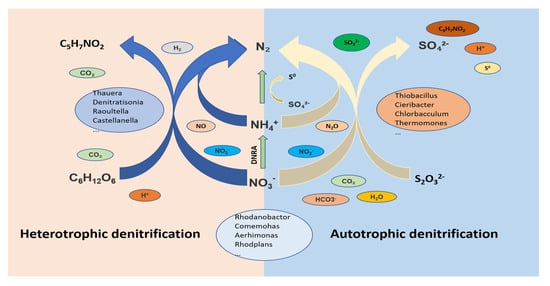
Figure 6.
Mechanism of nitrogen and sulfur transformation, and removal pathway of the coupled denitrification.
The biological reduction of nitrate is generally divided into three steps: (1) --N; (2) --N; (3) -N→N2. -N, an important reactant in heterotrophic and autotrophic denitrifications (Equations (1) and (2)), was required as electron donor, which ranged from 75.3 mg/L to 156.3 mg/L and from 0.877 mg/L to 1.8 mg/L in high and low concentration systems when -N removal efficiency was 93%. Whereas -N was found with a low inlet concentration of 1.85 mg/L and 0.45 mg/L, respectively, and a relatively higher outlet concentration during the above reaction process. The inlet wastewater with excess carbon source (TOC) was speculated to combine with different species and facilitate the switch of dissimilatory nitrate reduction to ammonium (DNRA) over denitrification during the initial stage of the entire reactor operation [38]. The conversion of nitrate to ammonium might be beneficial to the denitrification process; microorganisms were capable of using a relatively low level of ammonium in the system. Moreover, the DNRA reaction was weakened with a decrease in the carbon source, and residual -N might be due to endogenous decay [39,40]. This may explain the detection of -N even when complete denitrification was achieved gradually. The rate of the third step (-N→N2) was slower than that of the second step (--N), but was significantly accelerated by the addition of different amounts of electron donors. As previously analyzed, -N could be utilized as the preferred electron acceptor of the facultative denitrifier Rhodanobacter (reactor A) and heterotrophic denitrifier Denitratisoma (reactor B). Therefore, appropriate proportions of sulfur and carbon sources should be added to control -N denitrification in the -N stage in the collaborative denitrification system, which is positive to reduce substance consumption and production [20,41].
Therefore, at a substrate ratio of C/N/S of 1.3/1/1.9, and inlet nitrate concentrations of 10 or 960 mg/L, the addition of glucose and S2 promoted the coexistence of autotrophic, heterotrophic, and facultative bacteria, which significantly contributed to denitrification performance. However, the nitrate removal mechanisms may slightly differ under high/low concentrations due to distinct functional microbial species in reactors A and B.
4. Conclusions
The co-existence and complementation of heterotrophic and autotrophic denitrification was successfully achieved with a shorter start-up time by introducing mixed electron donors, such as glucose and sodium thiosulfate, resulting in improved denitrification performance. When the influent nitrate concentration was 960 mg/L and 10.95 mg/L at a substrate C/N/S ratio of 1.3/1/1.9, the nitrate removal efficiency reached approximately 93% in the coupled systems with nitrate removal loads of 3.52 kg/(m3·day) and 0.058 kg/(m3·day), respectively, which were considerably higher than those of the other denitrification process with single or mixed electron donors.
Under the conditions of varying inlet nitrate concentrations, the autotrophic, facultative, and heterotrophic bacteria could coexist and establish a mutual symbiotic relationship over time based on different pollutant concentrations. At low C/N ratios, the autotrophic denitrification process was predominant, but the second most prevalent denitrification gradually changed from heterotrophic to facultative with the increase in influent nitrate concentration. The synergistic cooperation of the key denitrifying bacteria Thiobacillus, Rhodanobacter, Rhodoplans, Thauera and Denitratisoma ultimately contributed to the improvement of nitrogen removal.
Author Contributions
Conceptualization, F.L. and S.W.; methodology, F.L.; software, Y.W.; validation, X.Z., F.Q. and Y.Y.; formal analysis, data curation and writing, S.W. All authors have read and agreed to the published version of the manuscript.
Funding
This research was funded by the Natural Science Foundation of Jiangsu Province, China, grant number BK20211339; and Shanghai Rising-Star Program, China, grant number 19QB1405300.
Institutional Review Board Statement
Not applicable.
Informed Consent Statement
Not applicable.
Data Availability Statement
No new data were created or analyzed in this study. Data sharing is not applicable to this article.
Acknowledgments
Authors acknowledge the support from the Innovation and Entrepreneurship Training Program of College Students, Suzhou University of Science and Technology, China.
Conflicts of Interest
The authors declare that they have no known competing financial interests or personal relationships that could have appeared to influence the work reported in this paper.
References
- Zhang, S.; Su, J.; Zheng, Z.; Yang, S. Denitrification strategies of strain ysf15 in response to carbon scarcity: Based on organic nitrogen, soluble microbial products and extracellular polymeric substances. Bioresour Technol. 2020, 314, 123733. [Google Scholar] [CrossRef]
- Rajanayaka, C.; Weir, J.; Barkle, G. Assessing changes in nitrogen contamination in groundwater using water aging: Waikato River, New Zealand. J. Contam. Hydrol. 2020, 234, 103686. [Google Scholar] [CrossRef]
- Zhao, X.; Wang, R.; Dong, L.; Li, W.; Li, M.; Wu, H. Simultaneous removal of nitrogen and dimethyl phthalate from low-carbon wastewaters by using intermittently-aerated constructed wetlands. J. Hazard. Mater. 2021, 404, 124130. [Google Scholar] [CrossRef]
- Wang, H.; Chen, N.; Feng, C.; Deng, Y. Insights into heterotrophic denitrification diversity in wastewater treatment systems: Progress and future prospects based on different carbon sources. Sci. Total Environment. 2021, 780, 146521. [Google Scholar] [CrossRef] [PubMed]
- Ucar, D.; Capua, F.D.; Yücel, A. Effect of nitrogen loading on denitrification, denitritation and filtration performances of membrane bioreactors fed with biogenic and chemical elemental sulfur. Chem. Eng. J. 2021, 419, 129514. [Google Scholar] [CrossRef]
- Qiu, T.; Liu, L.L.; Gao, M.; Zhang, L.; Tursun, H.; Wang, X. Effects of Solid-Phase Denitrification on the Nitrate Removal and Bacterial Community Structure in Recirculating Aquaculture System. Biodegradation 2016, 27, 165–178. [Google Scholar] [CrossRef] [PubMed]
- Tian, T.; Yu, H.Q. Denitrification with non-organic electron donor for treating low C/N ratio wastewaters. Bioresource Technol. 2020, 299, 122686. [Google Scholar] [CrossRef] [PubMed]
- Liang, J.; Nan, C.H.; Tong, S.; Liu, Y.; Feng, C. Sulfur autotrophic denitrification(SAD)driven by homogeneous composite particles containing CaCO3-type kitchen waste for groundwater remediation. Chemosphere 2018, 212, 954–963. [Google Scholar] [CrossRef] [PubMed]
- Zhou, W.; Liu, X.; Dong, X.; Wang, Z. Sulfur-based autotrophic denitrification from the micro-polluted water. J. Environ. Sci. 2016, 44, 180–188. [Google Scholar] [CrossRef]
- Cui, Y.X.; Biswal, B.K.; Guo, G.; Deng., Y.F.; Wu, D. Biological nitrogen removal from wastewater using sulphur-driven autotrophic denitrification. Appl. Microbiol. Biotechnol. 2019, 103, 6023–6039. [Google Scholar] [CrossRef]
- Liu, H.; Zeng, W.; Fan, Z.; Li, J. Effect of iron on enhanced nitrogen removal from wastewater by sulfur autotrophic denitrification coupled to heterotrophic denitrification under different substrate ratios. Chem. Eng. J. 2021, 421, 129828. [Google Scholar] [CrossRef]
- Wang, S.S.; Yi, H.C.; Zhang, H. Sulfur autotrophic denitrification filter and heterotrophic denitrification filter: Comparison on denitrification performance, hydrodynamic characteristics and operating cost. Environ. Res. 2021, 197, 111029. [Google Scholar] [CrossRef] [PubMed]
- Li, R.; Feng, C.; Hu, W. Woodchip-sulfur based heterotrophic and autotrophic denitrification(WSHAD) process for nitrate contaminated water remediation. Water Res. 2016, 89, 171–179. [Google Scholar] [CrossRef] [PubMed]
- Yu, Q.; Cheng, L.; Wua, B.C. Short term performance and microbial community of a sulfide-based denitrification and Anammox coupling system at different N/S ratios. Bioresour. Technol. 2019, 294, 122130. [Google Scholar]
- Du, S.; Ya, T.; Zhang, M.; Zhu, M.; Li, N.; Liu, S.; Wang, X. Distinct microbial communities and their networks in an anammox coupled with sulfur autotrophic/ mixotrophic denitrification system. Environ. Pollut. 2020, 262, 114190. [Google Scholar] [CrossRef]
- Erkan, S.; Adem, K. Heterotrophic and elemental-sulfur-based autotrophic denitrification processes for simultaneous nitrate and Cr(VI) reduction. Water Res. 2014, 50, 278–286. [Google Scholar]
- Oberoi, A.S.; Huang, H.; Khanal, S.K.; Sun, L.; Lu, H. Electron distribution in sulfur-driven autotrophic denitrification under different electron donor and acceptor feeding schemes. Chem. Eng. J. 2021, 404, 126486. [Google Scholar] [CrossRef]
- Qian, J.; Zhang, M.; Pei, X.; Zhang, Z.; Niu, J.; Liu, Y. A novel integrated thiosulfate-driven denitritation (TDD) and anaerobic ammonia oxidation (anammox) process for biological nitrogen removal. Biochem. Eng. J. 2018, 139, 68–73. [Google Scholar] [CrossRef]
- Qian, J.; Wei, L.; Wu, Y.; Wang, Q.; Fu, X.; Zhang, X.; Pei, X. A comparative study on denitrifying sludge granulation with different electron donors: Sulfide, thiosulfate and organics. Chemosphere 2017, 186, 322–330. [Google Scholar] [CrossRef]
- Yuan, Y.; Li, X.; Li, B. Autotrophic nitrogen removal characteristics of PN-anammox process enhanced by sulfur autotrophic denitrification under mainstream conditions. Bioresour. Technol. 2020, 316, 123926. [Google Scholar] [CrossRef]
- WE Federation; APHA. Standard Methods for the Examination of Water and Wastewater, 21st ed.; American Public Health Association: Washington, DC, USA, 2005. [Google Scholar]
- Han, F.; Zhang, M.; Shang, H.; Liu, Z.; Zhou, W. Microbial community succession, species interactions and metabolic pathways of sulfur-based autotrophic denitrification system in organic-limited nitrate wastewater. Bioresour. Technol. 2020, 315, 123826. [Google Scholar] [CrossRef]
- Liu, H.; Jiang, W.; Wan, D.; Qu, J. Study of a combined heterotrophic and sulfur autotrophic denitrification technology for removal of nitrate in water. J. Hazard. Mater. 2009, 169, 23–28. [Google Scholar] [CrossRef] [PubMed]
- Park, J.H.; Kim, S.H. Enhancement of nitrate removal in constructed wetlands utilizing a combined autotrophic and heterotrophic denitrification technology for treating hydroponic wastewater containing high nitrate and low organic carbon concentrations. Agric. Water Manag. 2015, 162, 1–14. [Google Scholar] [CrossRef]
- Park, S.; Seon, J.; Byun, I.; Cho, S.; Park, T.; Lee, T. Comparison of nitrogen removal and microbial distribution in wastewater treatment process under different electron donor conditions. Bioresour. Technol. 2010, 101, 2988–2995. [Google Scholar] [CrossRef] [PubMed]
- Li, R.; Feng, C.; Xi, B.; Chen, N.; Jiang, Y.; Zhao, Y.; Li, M.; Dang, Q.; Zhao, B. Nitrate removal efficiency of a mixotrophic denitrification wall for nitrate-polluted groundwater in situ remediation. Ecol. Eng. 2017, 106, 523–531. [Google Scholar] [CrossRef]
- Dan, C.; Kai, Y.; Li, W.; Hong, Y.W. Microbial community and metabolism activity in a bioelectrochemical denitrification system under long-term presence of p-nitrophenol, Bioresour. Technol. 2016, 218, 189–195. [Google Scholar]
- 30Sorokin, D.Y.; Kuenen, J.; Jetten, M. Denitrification at extremely alkaline condi-tions in obligately autotrophic alkaliphilic sulfur-oxidizing bacterium Thioalkalivibrio denitrificans. Arch. Microbiol. 2001, 175, 101. [Google Scholar]
- Zhu, T.-T.; Cheng, H.-Y.; Yang, L.-H.; Su, S.-G.; Wang, H.-C.; Wang, S.-S.; Wang, A.-J. Coupled sulfur and iron (II) carbonate-driven autotrophic denitrification for significantly enhanced nitrate removal. Environ. Sci. Technol. 2018, 53, 1545–1554. [Google Scholar] [CrossRef]
- Yang, Y.; Gerrity, S.; Collins, G.; Chen, T.; Li, R.; Xie, S.; Zhan, X. Enrichment and characterization of autotrophic Thiobacillus denitrifiers from anaerobic sludge for nitrate removal. Process Biochem. 2018, 68, 165–170. [Google Scholar] [CrossRef]
- Zhou, W.; Li, Y.; Liu, X.; He, S.; Huang, J.C. Comparison of microbial communities in different sulfur-based autotrophic denitrification reactors. Appl. Microbiol. Biotechnol. 2017, 101, 447–453. [Google Scholar] [CrossRef]
- 35Deng, S.; Peng, S.; Xie, B.; Yang, X.; Sun, S.; Yao, H.; Li, D. Influence characteristics and mechanism of organic carbon on denitrification, N2O emission and NO2−accumulation in the iron [Fe(0)]-oxidizing supported autotrophic denitrification process. Chem. Eng. J. 2020, 393, 124736. [Google Scholar]
- Huang, Z.; Wei, Z.; Xiao, X.; Tang, M.; Li, B.; Zhang, X. Nitrification/denitrification shaped the mercury- oxidizing microbial community for simultaneous Hg0 and NO removal. Bioresour. Technol. 2019, 274, 18–24. [Google Scholar] [CrossRef] [PubMed]
- Zhang, B.; Ji, M.; Qiu, Z.; Liu, H.; Wang, J.; Li, J. Microbial population dynamics during sludge granulation in an anaerobic–aerobic biological phosphorus removal system. Bioresour. Technol. 2011, 102, 2474–2480. [Google Scholar] [CrossRef]
- Sun, S.; Liu, J.; Zhang, M. Thiosulfate-driven autotrophic and mixotrophic denitrification processes for secondary effluent treatment: Reducing sulfate production and nitrous oxide Emission, Bioresour. Technol. 2020, 300, 122651. [Google Scholar] [CrossRef]
- Zhang, R.C.; Xu, X.J.; Chen, C.; Xing, D.F.; Shao, B.; Liu, W.Z. Interactions of functional bacteria and their contributions to the performance in integrated autotrophic and heterotrophic denitrification. Water Res. 2018, 143, 355–366. [Google Scholar] [CrossRef]
- Llorens-Marès, T.; Yooseph, S.; Goll, J.; Hoffman, J.; Vila-Costa, M.; Borrego, C.M.; Casamayor, E.O. Connecting biodiversity and potential functional role in modern euxinic environments by microbial metagenomics. ISME J. 2015, 9, 1648–1661. [Google Scholar] [CrossRef] [PubMed] [Green Version]
- Sun, F.; Deng, Q.; Li, X.; Tang, M.; Ma, X.; Cao, X.; Song, C. Organic carbon quantity and quality jointly riggered the switch between dissimilatory nitrate reduction to ammonium (DNRA) and denitrification in biofilters. Chemosphere 2021, 280, 1–9. [Google Scholar] [CrossRef] [PubMed]
- Moraes, B.S.; Souza, T.S.O.; Foresti, E. Effect of sulfide concentration on autotrophic denitrification from nitrate and nitrite in vertical fixed-bed reactor. Process Biochem. 2012, 47, 1395–1401. [Google Scholar] [CrossRef]
- Aalto, S.L.; Eero, A.; Tom, J.; Susanna, H. Autochthonous organic matter promotes DNRA and suppresses N2O production in sediments of the coastal Baltic Sea. Estuar. Coast. Shelf Sci. Vol. 2021, 255, 107369. [Google Scholar] [CrossRef]
- Liu, C.; Li, W.; Li, X.; Zhao, D.; Ma, B.; Wang, Y.; Lee, D.J. Nitrite accumulation in continuous-flow partial autotrophic denitrification reactor using sulfide as electron donor. Bioresour. Technol. 2017, 243, 1237–1240. [Google Scholar] [CrossRef]
Publisher’s Note: MDPI stays neutral with regard to jurisdictional claims in published maps and institutional affiliations. |
© 2021 by the authors. Licensee MDPI, Basel, Switzerland. This article is an open access article distributed under the terms and conditions of the Creative Commons Attribution (CC BY) license (https://creativecommons.org/licenses/by/4.0/).